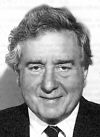
Born in Southport, Lancashire, Keith Runcorn attended the King George V Grammar School there before entering Gonville and Caius College, Cambridge, in 1940 to study engineering. After taking his bachelor's degree, he joined the Radar Research and Development Establishment at Malvern, Worcestershire, remaining there until the end of the Second World War. Then he moved to a junior academic post in the Physics Department at Manchester University, spending his first year there with a group working on cosmic rays before switching at the suggestion of P.M.S. Blackett, his department head, to geophysics, the subject which became Runcorn's abiding passion for the rest of his life. His allotted task was to determine how the Earth's magnetic field varies with depth, which involved carrying out magnetic measurements in deep coal mines in Kent, Lancashire and Yorkshire. As suggested by E.C. Bullard, the results would provide a test of a new theory of the Earth's magnetism that Blackett had just proposed. By 1950, the theory had been disproved not only by the "mine experiment", in which Runcorn was helped by A.C. Benson, D.H. Griffiths, A.F. Moore, J. Pickering and others, but also by the results of a delicate laboratory experiment conducted by Blackett himself, requiring the design and construction by him of a very sensitive magnetometer. This instrument later enabled groups headed by Blackett and Runcorn to make important advances in the field of rock magnetism.
In 1950 Runcorn returned to Cambridge, where he spent the next six years as Assistant Director of Research in the Department of Geodesy and Geophysics. With several research students, including D.W. Collinson, K.M. Creer, R. Hide, H. Hughes, E. Irving, F.J. Lowes, A.F. Moore, J.M. Perry, P.H. Roberts, D.C. Tozer and others he expanded the research programme of the department in several directions. His own personal research was crucially influenced in 1951 by new results on polarity reversals of the Earth's magnetic field that were emerging from studies of the magnetism of Icelandic lava flows being made at Cambridge by J.Hospers under the supervision of B.C. Browne, the head of the department. With Collinson, Creer and Irving, and in parallel with work already under way in Manchester by Blackett and J.A. Clegg, Runcorn orchestrated at Cambridge a vigorous programme of field and laboratory studies for determining the fossilized ancient directions of the Earth's magnetic field in sedimentary and igneous rocks from several parts of the world. The results of this venture provided the Manchester and Cambridge groups with striking new evidence in favour of Alfred Wegener's celebrated but then controversial "continental drift" hypothesis. Details of this story need not be given here, for they have been repeated many times in accounts of the events leading up to the introduction by others in the 1960's of the highly successful theory of plate tectonics.
The next change in Runcorn's career was his move in 1956 to a chair of physics in the University of Durham and headship of the Department of Physics at King's College, Newcastle-upon-Tyne (later the University of Newcastle-upon-Tyne), a post he would occupy for the next thirty-two years, until 1988 when on reaching the official retirement age he left Newcastle and became attached to Imperial College London. Aided by ex-students filling new junior posts in his department, he rapidly put Newcastle on the "geophysical" map. Visitors came from several countries to carry out research there or to participate in wide-ranging NATO-sponsored international scientific discussion meetings, during which they were invariably abe to enjoy the magnificent scenery of Northumberland as seen from Hadrian's Wall, admire the splendours of Durham Cathedral and York Minster, or sample Newcastle Brown Ale in one of the many pubs, often with Runcorn as an indefatigable companion and knowledgeable guide. Throughout his career, Runcorn was wedded to the promotion of geophysics by almost incessant traveling on lecture tours, but at no stage did he consider it necessary to hand over the headship of the Physics Department in Newcastle to one of the patient and hard-working members of his very able staff, with whom he kept in touch during long periods of absence from Newcastle by means of telephone calls and picture post cards from distant parts of the world.
Once described as the "theoretical visiting professor of physics in Newcastle", Runcorn derived amusement from a remark by an American friend to the effect that "the average speed of motion of geophysicists relative to the Earth's surface is about sixty miles per hour, and we rely on you, Keith, to make up for those of us who prefer to work close to home". But he never stopped thinking about the physics of the Earth and planets, and at most geophysical meetings he could be found entertaining audiences with his latest musings about the magnetism of the Moon, convection in planetary interiors or geomagnetic polarity reversals. He greatly enjoyed his interaction with fellow scientists all over the world, whom he would visit or telephone frequently seeking information and help of various kinds. And he took pride not only in awards received in recognition of his contributions to geophysics, which include several honorary degrees, Fellowship of the Royal Society, the Fleming Medal of the American Geophysical Union and the Gold Medal of the Royal Astronomical Society, but also in the success of the European Geophysical Society, which he had a hand in founding in 1971, and in the attainments of many ex-students and other associates fortunate enough to have been influenced early in their careers by his infectious enthusiasm for geophysics.
Raymond Hide